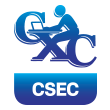By Michael Peters
Born out of a need to have exam results returned in time to issue report cards, e-testing is rapidly becoming a standard testing format at Convent High School (CHS) in Dominica. The benefits have become clearer with each implementation: saving cost, time, and enhancing the quality of the questions, the exams and the learning process.
 In December 2015, issuing an exam similar to a Caribbean Secondary Education Certificate (CSEC) Electronic Document Preparation and Management (EDPM) exam at the Form 1 level and having one teacher return the results of 100-plus papers within a week posed a challenge. The Information Systems Department decided to focus on the practical assessments during the term and end with a summative multiple-choice exam. That multiple-choice exam took an electronic format; this decision was further prompted by the increasing printing cost, coupled with the breakdown of a large format copier just weeks before the exams.
In December 2015, issuing an exam similar to a Caribbean Secondary Education Certificate (CSEC) Electronic Document Preparation and Management (EDPM) exam at the Form 1 level and having one teacher return the results of 100-plus papers within a week posed a challenge. The Information Systems Department decided to focus on the practical assessments during the term and end with a summative multiple-choice exam. That multiple-choice exam took an electronic format; this decision was further prompted by the increasing printing cost, coupled with the breakdown of a large format copier just weeks before the exams.
The testing platform was the Learning Management System (LMS) Moodle. The questions were quickly reformatted,
categorized and uploaded in bulk to reusable question banks. This format allowed use of appropriately sized and
coloured images to enhance the questions, an improvement which was not previously practical due to printing cost and additional paper usage.
Pretesting was done to familiarise the students with the new exam format and to establish system requirements. Students made recommendations, were instrumental in resolving issues, and the students’ positive feedback was the major approval needed for launching into this new testing format.
E-testing was used for the Information and Communications Technology test in Forms 1, 2, and 3 in the first instance. There were a few shortcomings due to limited hardware resources; but, the feedback with reference to the format was mainly positive. Students felt a bit more in control of the exam. After commencing the exam,
students were able to monitor their progress while comparing the current question to the countdown clock. Additionally, students were able to flag questions for later review prior to submission. Flagging the questions
also served to alert to teachers of questions that were perceived as difficult by students.
 With the announcement that it was going to be implementing online testing by 2018, the staff, with little or no prompting by the Principal, decided to convert the multiple-choice exams to the e-testing format. For the June 2016, Term 3 examinations, most Form 4 multiple-choice exams were tested in this format, only limited by the number of computers available in the lab. Once more, the IT Department handled most of the technical work. A few members of staff from each department were trained in preparing the questions in the required format. At each
With the announcement that it was going to be implementing online testing by 2018, the staff, with little or no prompting by the Principal, decided to convert the multiple-choice exams to the e-testing format. For the June 2016, Term 3 examinations, most Form 4 multiple-choice exams were tested in this format, only limited by the number of computers available in the lab. Once more, the IT Department handled most of the technical work. A few members of staff from each department were trained in preparing the questions in the required format. At each
subject level, all questions were pooled, the question banks became larger, large enough to create three or more exams at the subject level in some cases. Multiple exams of different subjects and durations ran concurrently. The students walked into the examination room, a computer lab in this case, logged on, did the exam and left.
Benefits
Besides having access to all their students’ marks immediately after the last student completed the exam, teachers began to see other advantages for the future. From a collection of 20 questions on a particular topic, teachers could prepare more questions – review tests and end of chapter tests. Those questions could be reused in mid-term tests and exams. Another advantage is that random question selection can be adopted for each student
taking a test. The analysis of the results done by the LMS allows for question review and elimination of faulty questions or adopting a different approach to teaching, and hopefully result in better test results. With extensive refining work, teachers can adopt a set-it-and-forget-it approach, knowing that the quizzing component of their course is already done for at least a year in the future.
CHS uses the services and tools provided by Google Apps for Education platform. Some new features available to
teachers this year include Google Forms, now allowing a quiz format. Google Forms can be prepared with the multiple-choice format and automatically corrected and graded immediately on submission or at a later time when all students have completed their sessions. With optional feedback for student response – correct answer, incorrect answer, and comment – students know their results on completion of the assessment. This may not always be practical for an exam, but it is practical for review and chapter quizzes. As of September 2016, the Science Department has already begun testing and using these features. The mood among staff and students appears to be one of no turning back. Slowly but surely other teachers and departments are beginning to implement some form of e-testing and the concept is not limited to multiple-choice type questions.
 While the focus of e-testing is not and should not be to eliminate cheating, the format does reduce cheating attempts. In a proctored setting, with the questions being shuffled and the options for each question being shuffled, students would need to invest a lot more time into cheating. The expected shuffle settings for 60 students doing a 60-question test is that no two students will have the same question one. When students get to the same question then there is a one in four chance that they have the same first option. Shuffling both
While the focus of e-testing is not and should not be to eliminate cheating, the format does reduce cheating attempts. In a proctored setting, with the questions being shuffled and the options for each question being shuffled, students would need to invest a lot more time into cheating. The expected shuffle settings for 60 students doing a 60-question test is that no two students will have the same question one. When students get to the same question then there is a one in four chance that they have the same first option. Shuffling both
questions and options is a setting applied in most of the assessments. As a result, very few attempts to communicate that would lead to cheating were identified. This may have resulted from the fact that during
the pretesting period and student training sessions, the students recognised that the questions and options were shuffled, and that it was difficult to communicate the question context and option answer.
Policy changes are required to take full advantage of e-testing. Schools will have policies that determine how, when, where, and in what setting students should write tests. Based on the method of issue, the value of the e-testing assessment is beyond doubt. Allowing students to retake tests, take tests at different times, and in a non-proctored setting can compromise a test. As such, safe browsers and video monitoring are some of the methods adopted to monitor students taking online tests.
As with all forms of technology, e-testing should be implemented where practical. With the collaborative effort of teachers, schools, districts and the ministry of education, e-testing is ready to take its place in our education – we just need to welcome it!
Michael Peters is the Systems Administrator at Convent High School in Dominica













